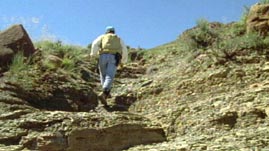One of the most dramatic and mysterious events in the history of life, the so-called "Great Dying" of animals and plants some 250 million years ago, continues to fascinate and baffle scientists. Of the five or so mass extinctions recorded in Earth's fossils, this one at the end of the Permian period and the start of the Triassic was the most catastrophic.
More than half of the families of living things died out, and as many as 90 to 96 percent of the planet's marine species were lost. At the same time, perhaps 70 percent of the land's reptile, amphibian, insect, and plants species went extinct.
The $64,000 question is what event, or chain of events, could have wreaked such environmental disaster? It's a bit like trying to solve a 250-million-year-old crime -- the trail is cold, and many clues have been destroyed. At this time the continents as we know them today were assembled into a single landmass called Pangaea, which did not start to break up until the middle of the Triassic period. This gargantuan supercontinent, scientists suspect, disrupted the circulation of seawater, making the oceans stagnant. The consequent depletion of oxygen in the water and high concentrations of dissolved carbon dioxide rendered the ocean bottom something like an enormous bog.
The anoxic (oxygen-lacking) waters could have spilled onto the continental shelves, the high carbon dioxide content, toxic to marine life, poisoning much of the life in the oceans. At the same time, massive outpourings of volcanic basalt rock in what is now Siberia added huge amounts of heat, carbon dioxide, and sulfur dioxide to Earth's surface and atmosphere. The carbon dioxide could have trapped heat in the atmosphere, and the resulting "greenhouse effect" generated a long warming trend.
The climate change triggered by the warming could have shifted weather patterns dramatically, so that regions normally wet and rainy became dry and vice versa. Geologic evidence supporting this hypothesis has been found in recent investigations in the Caledon River in South Africa.
Did all these factors -- sea-level change, climate change, ocean stagnation, carbon dioxide buildup -- combine to cause the Great Dying? We don't have all the answers. And, in fact, in 2001 a group of scientists uncovered evidence suggesting that an asteroid may have hit Earth at the end of the Permian era, further complicating the picture. The evidence is still circumstantial, however, and what role, if any, an impact may have played is unclear.
Scientists continue to examine the evidence for clues to the cause of the Permian-Triassic extinction. But this dramatic event happened so long ago that we may never know for certain what wiped out so much of life on Earth in the Great Dying.


 Loading Standards
Loading Standards Teachers' Domain is proud to be a Pathways portal to the National Science Digital Library.
Teachers' Domain is proud to be a Pathways portal to the National Science Digital Library.
